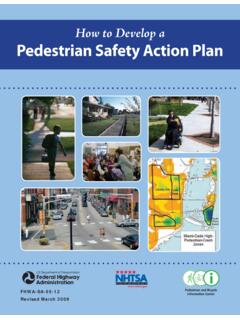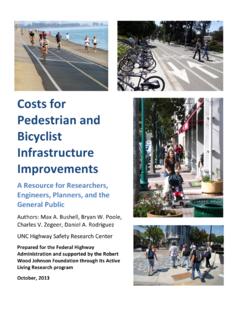Transcription of safety.fhwa.dot.gov
1 fhwa COURSE ON BICYCLE. AND PEDESTRIAN TRANSPORTATION. L E S S O N 1 3. Walkways, Sidewalks, and Public Spaces Purpose gain access to and depart from signalized intersec- No single design feature can ensure that a tions in an orderly and efficient manner. streetscape will be attractive to pedestrians. Rather, the best places for walking combine many design Minimum Width of Sidewalks elements to create streets that feel right to people Sidewalks require a minimum width of feet if set on foot. Street trees, separation from traffic, back from the curb or feet if at the curb face. Any seating areas, pavement design, lighting, and many width less than this does not meet the minimum other factors should be considered in locations requirements for people with disabilities.
2 Walking is where pedestrian travel is accommodated and a social activity. For any two people to walk together, encouraged. This lesson provides an overview of feet of space is the bare minimum. In some areas, these design elements, with examples of successful such as near schools, sporting complexes, some streetscapes throughout the United States. parks, and many shopping districts, the minimum width for a sidewalk is feet. Thus, any existing Basic Urban Sidewalk sidewalks (permitted as an AASHTO. minimum) often force pedestrians into the roadway Requirements All urban sidewalks require the following basic ingredients for success: adequate width of travel lanes, a buffer from the travel lane, curbing, minimum width, gentle cross-slope (2 percent or less), a buffer to private properties, adequate sight distances around corners and at driveways, shy distances to walls and other structures, a clear path of travel free of street furniture, continuity, a well-maintained condition, ramps at corners, and flat areas across driveways.
3 Sidewalks also require sufficient storage capacity at corners so that the predicted volume of pedestrians can WALKWAYS, SIDEWALKS, AND. PUBLIC SPACES. 13 - 1. fhwa . fhwa COURSE ON BICYCLE. AND PEDESTRIAN TRANSPORTATION. in order to talk. Even children Be sure to calculate the commer- walking to school find that a cial need for outdoor cafes, foot width is not adequate. kiosks, corner gathering spots, and other social needs for a Desirable Sidewalk Width sidewalk. Sidewalk widths have The desirable width for a not been given sufficient sidewalk is often much greater. attention by most designers. Some shopping districts require When working in a commercial 12, 20, 30, and even 40 feet of area, designers should always width to handle the volumes of consult property owners, pedestrian traffic they encoun- chambers of commerce, and ter.
4 Pennsylvania Avenue in landscape architects to make Washington, has 30-foot For two people to walk abreast, 5 feet is the bare sidewalk sections to handle tour certain that the desired width is minimum for sidewalk width. bus operations, K Street in realistic. Corner or mid-block Washington, has 20=foot sections to handle bulb-outs can be used to their advantage for creating transit off-loading and commercial activity, the both storage space for roadway crossings and for commercially successful Paseo de Gracia boulevard social space. in Barcelona, Spain has 36 to 48 feet in most sections. The safety needs of motorists and bicyclists in the Designers must pay close attention to minimums, and roadway must be considered when determining the only use variances below these levels for short desirable widths of adjacent sidewalks.
5 There is sections. On the other side of the width equation, compelling evidence that generous lane width (12- overly ample sidewalk widths are rarely justified. It is foot) standards applied to downtown and commercial essential to work out the peak volumes of transit streets are counterproductive and lead to faster discharge, the likely commercial appeal of an area, traffic. and the influence of large tour buses and other factors when designing public space. AASHTO specifically permits 10- or 11-foot travel lanes on arterials in commercial districts, and also Chapter 13 of the Highway Capacity Manual covers permits turning lanes to be restricted to 10 feet. the topics of sidewalk width and pedestrian level of Truck volumes and the volume of bicycles must also service.
6 Be factored into this equation. As a general rule, when speeds are at or near bicycle speeds (15 to 20. mph), then bike lanes may not be as essential as the appropriate width of sidewalk. The designer is reminded that in Central Business Districts (CBD), the pedestrian volume may be 50 to 90. percent of total traffic. When these needs are not met, the commercial and social success of the community is lessened, and safety may be compromised. Paving Materials Although most sidewalks are made of concrete, in some instances, asphalt can provide a useful surface. Including ammenities such as newspaper stands and kiosks along corners creates On trails, joggers and some others lively, more defined spaces; however, they should not interrupt the flow of pedestrian prefer asphalt.
7 As a general rule, traffic. WALKWAYS, SIDEWALKS, AND. PUBLIC SPACES. 13 - 2. fhwa . fhwa COURSE ON BICYCLE. AND PEDESTRIAN TRANSPORTATION. however, the long life of concrete, and the distinct pattern and lighter color are preferred. Paver stones can also be used, and in some applications, they have distinct advantages (see section later in this lesson). Border Areas and Buffers A border area should be provided along streets for the safety of motorists and pedestrians as well as for aesthetic reasons. The border area between the roadway and the right-of-way line should be wide enough to serve several The width of a natural buffer provides the essential space needed for situations such purposes, including provision of a as protecting pedestrians from out-of-control vehicles.
8 Buffer space between pedestrians and vehicular traffic, sidewalk space, snow storage, downtown areas, nature strips are also a convenient an area for placement of underground utilities, and an location for the swing-width of a door, for place- area for maintainable esthetic features such as grass ment of parking meters, hydrants, lampposts, and or other landscaping. The border width may be a other furniture. minimum of 5 feet, but desirably, it should be 10 feet or wider. Wherever practical, an additional obstacle- Another way to achieve border width and the needed free buffer width of 12 feet or more should be buffer from traffic is to provide bike lanes. This 5-foot provided between the curb and the sidewalk for space creates a minimal safe width to the sidewalk, safety and environmental enhancement.
9 In residential even when at the back of the curb; reduces the areas, wider building setback controls can be used to effects of noise and splashing; and provides a higher attain these features. (AASHTO, A Policy on level of general comfort to the pedestrian. Geometric Design of Highways & Streets, 1990) On-street parking has two distinct advantages for the The preferred minimum width for a nature strip is 5 to pedestrian. First, it creates the needed physical 7 feet. A nature strip this wide provides ample separation from the motorist. Second, on-street storage room for many utilities. The width provides: parking has been shown to reduce motorist travel speeds. This creates an environment for safer street An essential buffer between an out-of-control crossings.
10 Motorist and a pedestrian. Improved sight distances at driveways. On the back side of sidewalks, a minimum width Adequate width for landscaping and street trees. buffer of 1to 3 feet is essential. Without such a buffer, vegetation, walls, buildings, and other objects A tree set back from the roadway feet meets encroach on the usable sidewalk space. With just minimum AASHTO standards for fixed objects when several months of growth, many shrubs will dominate a a barrier curb is used (30 mph or less), and is ad- sidewalk space. This setback is essential, not only to equate for most species. The area is ample for most the walking comfort of a pedestrian, but to ensure snow storage. When this preferred minimum cannot essential sight lines at each residential and commer- be achieved, any width, down to feet or even cial driveway.














